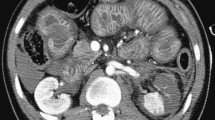Abstract
Hypoperfusion complex is an uncommon entity found on computed tomography (CT) of blunt trauma. It is more common in children compared to adults. Everyone should be aware of this entity to interact with clinicians to aid in triage and management of patients in view of poor prognosis. It is also important to prevent unnecessary laparotomies by confusing abdominal organ injuries. There are certain visceral and vascular findings described on abdominal CT that would alert the radiologist for this entity. This pictorial review should increase radiologists’ awareness and recognition of the CT manifestations of hypoperfusion complex before an irreversible state of shock occurs in blunt abdominal trauma.













Similar content being viewed by others
References
Taylor GA, Fallat ME, Eichelberger MR (1987) Hypovolemic shock in children: abdominal CT manifestations. Radiology 164:479–481
Wiesner W, Khurana B, Ji H, Ros PR (2003) CT of acute bowel ischemia. Radiology 226:635–650
Wittenberg J, Harisinghani MG, Jhaveri K, Varghese J, Mueller PR (2002) Algorithmic approach to CT diagnosis of the abnormal bowel wall. RadioGraphics 22:1093–1109
Mirvis SE, Shanmuganathan K, Erb R (1994) Diffuse small-bowel ischemia in hypotensive adults after blunt trauma (shock bowel): CT findings and clinical significance. Am J Roentgenol 163:1375–1379
O’Hara SM, Donnelly LF (1999) Intense contrast enhancement of the adrenal glands: another abdominal CT finding associated with hypoperfusion complex in children. AJR Am J Roentgenol 173:995–997
Berland LL, VanDyke JA (1985) Decreased splenic enhancement on CT in traumatized hypotensive patients. Radiology 156:469–471
Robert JH, Toledano AE, Toth LS, Premus G, Dreiling DA (1988) Hypovolemic shock, pancreatic blood flow, and pancreatitis. Int J Pancreatol 3:283–292
Catalano OA, Napolitano M, Vanzulli A (2005) Black kidney sign: a new computed tomographic finding associated with the hypoperfusion complex in children. J Comput Assist Tomogr 29(4):484–486
Tarrant AM, Ryan MF, Hamilton PA, Benjaminov O (2008) A pictorial review of hypovolaemic shock in adults. Br J Radiol 81(963):252–257
Ryan MF, Hamilton PA, Sarrazin J, Chu P, Benjaminov O, Lam K (2005) The halo sign and peripancreatic fluid: useful CT signs of hypovolaemic shock complex in adults. Clin Radiol 60:599–607
Author information
Authors and Affiliations
Corresponding author
Rights and permissions
About this article
Cite this article
Prasad, K.R., Kumar, A., Gamanagatti, S. et al. CT in post-traumatic hypoperfusion complex—a pictorial review. Emerg Radiol 18, 139–143 (2011). https://doi.org/10.1007/s10140-010-0927-2
Received:
Accepted:
Published:
Issue Date:
DOI: https://doi.org/10.1007/s10140-010-0927-2




